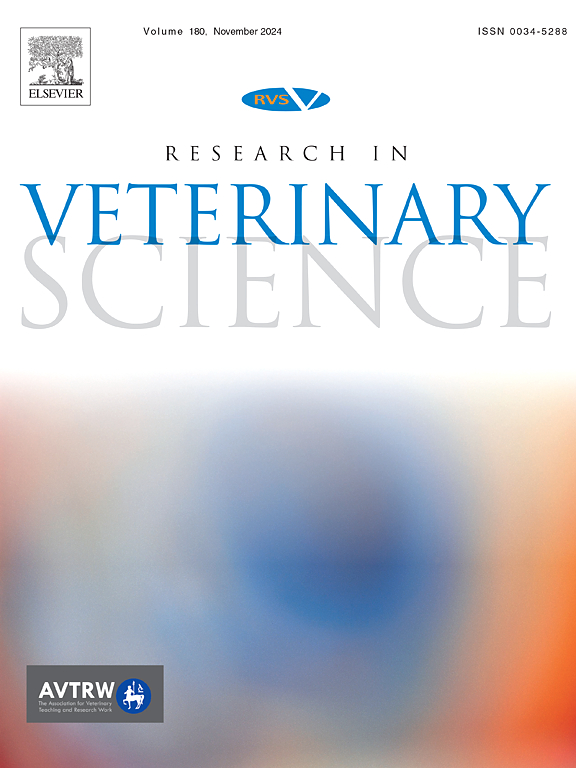意大利北部家畜密集区奶牛散装罐奶中金黄色葡萄球菌、耐甲氧西林葡萄球菌和哺乳动物球菌
IF 2.2
3区 农林科学
Q1 VETERINARY SCIENCES
引用次数: 0
摘要
金黄色葡萄球菌是传染性奶牛乳腺炎的主要病原,而非金黄色葡萄球菌和哺乳球菌(NASM)是最常从牛奶中分离出来的细菌。除了对动物健康的影响外,NASM还可能携带具有与金黄色葡萄球菌双向转移潜力的抗微生物药物耐药性(AMR)基因,并且耐甲氧西林(MR)葡萄球菌(MRS)可能引起重大的One health问题。在我们的研究中,我们评估了意大利北部伦巴第省洛迪省88个奶牛场散装罐奶(BTM)中MRS的患病率和特征。32.95%的BTM样品分离到金黄色葡萄球菌,其中以核糖体间隔PCR (RS-PCR)基因型最多,在37.93%的金黄色葡萄球菌阳性猪场中检出。所有分离株均携带ica基因(icaA, icaB, icaC, icaD),表明有可能产生生物膜。56.81%的养殖场分离出MRS。MALDI-TOF MS分析显示,最常见的MR种为表皮葡萄球菌(MRSE)(35.59%),其次为金黄色葡萄球菌(MRSA)(18.64%)、sciuri金黄色葡萄球菌(15.25%)、腐生葡萄球菌(11.86%)、北方葡萄球菌(6.78%)、溶血葡萄球菌(5.08%)、fleurettii金黄色葡萄球菌(3.39%)、cohnii金黄色葡萄球菌和pettenkoferi金黄色葡萄球菌(1.70%)。大多数MR分离株携带mecA基因,而没有携带mecC。葡萄球菌盒式染色体mec (SCCmec)在MRSA中以V型为主(45.45%),在MRSE中以IV型为主(61.90%)。鉴于它们与“同一个健康”的相关性,监测从牛奶中分离的所有葡萄球菌和哺乳球菌的抗菌素耐药性对于了解奶牛群中MR基因库的流行、特征和传播动态至关重要。本文章由计算机程序翻译,如有差异,请以英文原文为准。

Staphylococcus aureus and methicillin-resistant staphylococci and mammaliicocci in the bulk tank milk of dairy cows from a livestock-dense area in northern Italy
Staphylococcus aureus is the main etiologic agent of contagious dairy cow mastitis, while non-aureus staphylococci and mammaliicocci (NASM) are the bacteria most frequently isolated from milk. Beyond their impact on animal health, NASM can harbor antimicrobial resistance (AMR) genes with potential for bidirectional transfer with S. aureus, and methicillin-resistant (MR) staphylococci (MRS) can raise significant One Health concerns. In our study, we evaluated the prevalence and characteristics of MRS in the bulk tank milk (BTM) of 88 dairy farms in the livestock-dense province of Lodi, Lombardy, northern Italy. S. aureus was isolated from 32.95 % of BTM samples, with the Ribosomal Spacer PCR (RS-PCR) genotype B being the most prevalent, identified in 37.93 % of S. aureus positive farms. All isolates carried the ica genes (icaA, icaB, icaC, icaD) indicating the potential to produce biofilm. MRS were isolated in 56.81 % of farms. According to MALDI-TOF MS analysis, the most prevalent MR species included S. epidermidis (MRSE, 35.59 %) followed by S. aureus (MRSA, 18.64 %), M. sciuri (15.25 %), S. saprophyticus (11.86 %), S. borealis (6.78 %), S. haemolyticus (5.08 %), M. fleurettii, (3.39 %), S. cohnii, and S. pettenkoferi (1.70 % each). Most MR isolates carried the mecA gene, while none carried mecC. The staphylococcal cassette chromosome mec (SCCmec) was predominantly type V in MRSA (45.45 %) and type IV in MRSE (61.90 %). Given their relevance to One Health, monitoring AMR in all staphylococci and mammaliicocci isolated from milk is essential for understanding the prevalence, characteristics, and transmission dynamics of MR gene pools within dairy herds.
求助全文
通过发布文献求助,成功后即可免费获取论文全文。
去求助
来源期刊

Research in veterinary science
农林科学-兽医学
CiteScore
4.40
自引率
4.20%
发文量
312
审稿时长
75 days
期刊介绍:
Research in Veterinary Science is an International multi-disciplinary journal publishing original articles, reviews and short communications of a high scientific and ethical standard in all aspects of veterinary and biomedical research.
The primary aim of the journal is to inform veterinary and biomedical scientists of significant advances in veterinary and related research through prompt publication and dissemination. Secondly, the journal aims to provide a general multi-disciplinary forum for discussion and debate of news and issues concerning veterinary science. Thirdly, to promote the dissemination of knowledge to a broader range of professions, globally.
High quality papers on all species of animals are considered, particularly those considered to be of high scientific importance and originality, and with interdisciplinary interest. The journal encourages papers providing results that have clear implications for understanding disease pathogenesis and for the development of control measures or treatments, as well as those dealing with a comparative biomedical approach, which represents a substantial improvement to animal and human health.
Studies without a robust scientific hypothesis or that are preliminary, or of weak originality, as well as negative results, are not appropriate for the journal. Furthermore, observational approaches, case studies or field reports lacking an advancement in general knowledge do not fall within the scope of the journal.
 求助内容:
求助内容: 应助结果提醒方式:
应助结果提醒方式:


